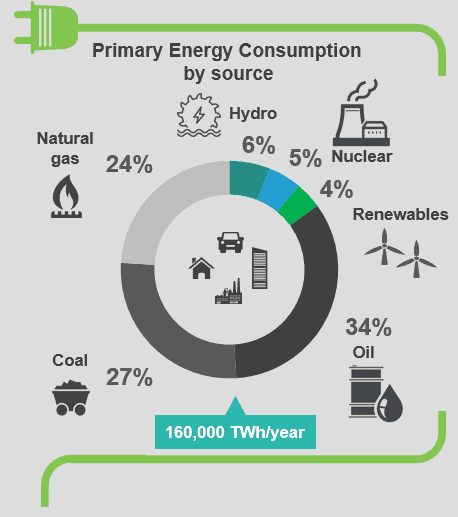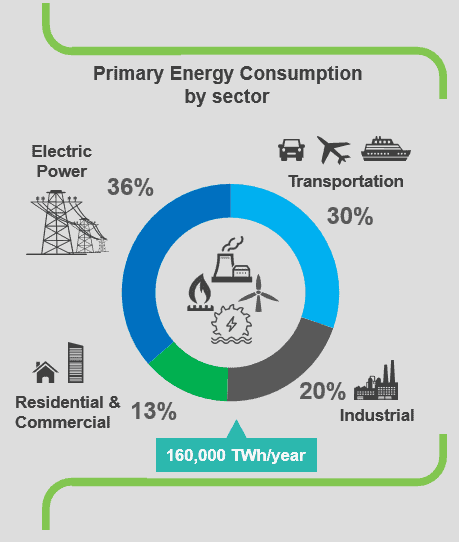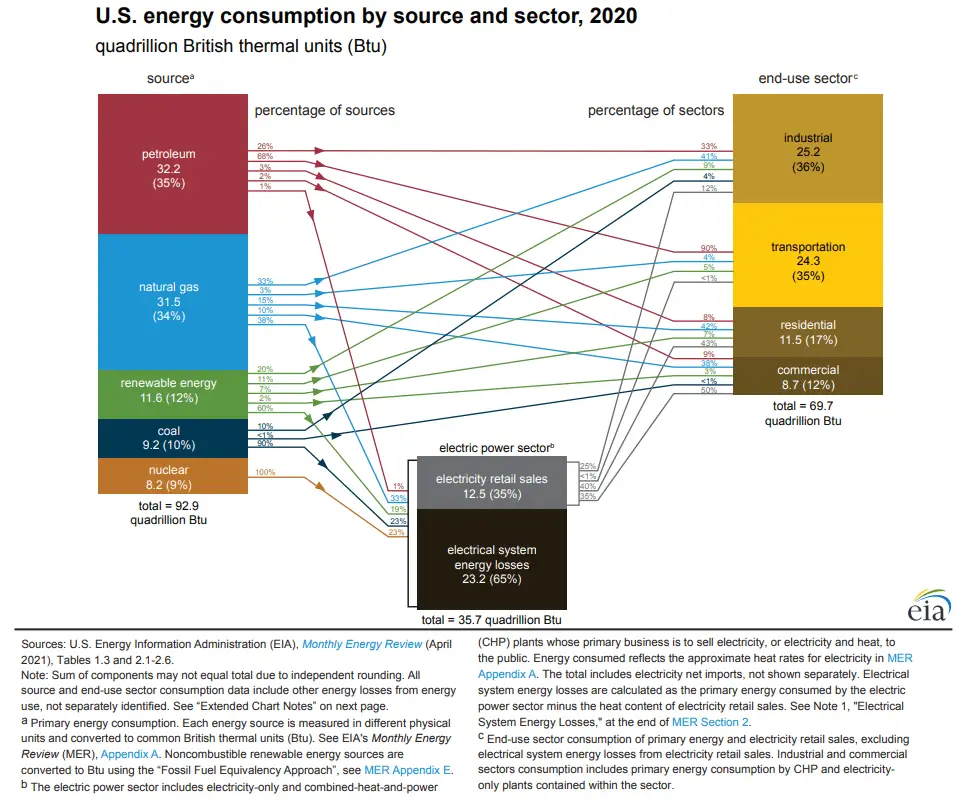What are the primary energy sources?
The world’s main primary energy sources consisted of petroleum (34%), coal (27%), and natural gas (24%), amounting to an 85% share for fossil fuels in primary energy consumption in the world.
Industry, transportation, and the residential sector consume even more primary resources than electricity generation.
To achieve a low-carbon economy, electricity generation has to triple, and it must be based on low-carbon sources.
Hydrogen and electricity are produced from primary energy, and we cannot say that they have the potential to offset fossil fuels.
All energy transformations are associated with energy losses.
We must distinguish between primary and secondary energy sources when studying energy resources. Primary energy (PE) is an energy resource found in nature (oil, coal) that has not been subjected to any conversion or transformation process. It is the energy contained in raw fuels and other forms of energy received as input to a system. Hydrogen and electricity belong to secondary energy sources, so they must be produced from primary energy sources.
- Direct consumption of primary energy. Primary energy sources are not only consumed in power plants. Assuming oil refining is not a transformation process, most primary energy today is consumed directly in the transportation, industrial and residential sectors.
- Transformation. Primary energy sources are transformed in energy conversion processes to more convenient forms of energy that can directly be used by society, such as electrical energy or synthetic fuels such as hydrogen. But most of these secondary sources (energy carriers) today are produced primarily from fossil primary energy.
Primary energy sources take many forms, including:
- Solar energy. The primary energy source for solar, wind, hydropower, and biofuels is the Sun. The Sun is the star at the center of the Solar System. It is heated to incandescence by nuclear fusion reactions in its core, radiating the energy mainly as visible light, ultraviolet light, and infrared radiation. It is by far the most important energy source for life on Earth.
- Fossil energy. Fossil fuels are hydrocarbon-containing materials formed underground from the remains of dead plants and animals. Fossil energy is a type of stored solar energy. These fuels are found in the Earth’s crust and contain carbon and hydrogen, which can be burned for energy. The main fossil fuels are coal, petroleum, and natural gas, which humans extract through mining and drilling.
- Nuclear energy. Nuclear energy comes either from spontaneous nuclei conversions or induced nuclei conversions. Because humankind has learned to control the transformation of nuclei, nuclear energy is also one of the primary energy sources.
- Geothermal energy. Geothermal energy is heat within the Earth, which originates from the planet’s formation and the radioactive decay of materials. Moreover, the decay heat of uranium and thorium and their decay products (e.g., radon, radium, etc.) contribute to heating the Earth’s core. Together with potassium-40 in the Earth’s mantle, these elements are the main source of heat that keeps the Earth’s core liquid.
- Tidal energy. Tidal energy is a form of power produced by the natural rise and fall of tides caused by the gravitational interaction between Earth, the Sun, and the moon.
Global direct primary energy consumption in 2020 was about 160,000 TWh (576 exajoules or 545 quadrillions BTU).
This is equivalent to three hundred million coal wagons or a mountain of coal 4 times larger than Mount Kilimanjaro.
The real challenge is the capacity needed to supply low-carbon energy in all sectors (electricity generation, transportation, industry, and residential). We mostly talk about the share of low-carbon sources in power generation, which consumes “only” a third of fossil resources. Transportation, industry, and residential sectors consume about two-thirds of fossil resources. The transition of these sectors to low-carbon sources (e.g., using power-to-gas) is actually based on the transition of these sectors to low-carbon power generation with sufficient energy storage. The higher the share of these sources in the energy mix, the higher the demands on the transmission and energy storage systems. To achieve a low-carbon economy, electricity generation has to triple (or more, assuming energy conversion losses), and it must be based on low-carbon sources.
What are secondary energy sources?
Sometimes people use bad arguments when they say that fossil fuels can simply be replaced by hydrogen or others, such as e-fuels. That prevents useful debate instead of furthering it. This argument is not valid because we must produce secondary energy from primary energy sources. Moreover, the conversion never reaches 100%, usually due to the Laws of Thermodynamics. Therefore to produce, let’s say, 1 MJ of secondary source, you have to use more than 1MJ of primary energy (let’s say 2MJ). As much as we think that electricity, hydrogen, or e-fuels are the future, these fuels are “only” energy carriers. Sustainable primary sources, such as solar, nuclear, or geothermal energy, are needed to produce them. Secondary energy sources such as hydrogen, e-fuel, or electricity will never be sustainable if produced from unsustainable primary sources (as they do today).
Secondary energy sources, also called energy carriers, are derived from the transformation of primary energy sources. They are called energy carriers because they move energy in a usable form from one place to another. The well-known energy carriers are:
- Electricity. Electricity is particularly useful since it has low entropy (is highly ordered) and can be converted into other forms of energy very efficiently.
- Petrol. Petroleum products, such as motor gasoline, distillate fuel oil, and hydrocarbon gas liquids, have remained the largest sources of primary energy consumed.
- Hydrogen
- e-fuels (synthetic fuels)
Electricity and hydrogen are made from primary energy sources such as coal, natural gas, nuclear energy, petroleum, and renewable energy sources. We cannot mine hydrogen similarly as we cannot mine electricity. Electricity is particularly useful since it has low entropy (is highly ordered) and can be converted into other forms of energy very efficiently.
Example: Current hydrogen production
As of 2020, most hydrogen (∼95%) is produced from fossil fuels by steam reforming of natural gas, partial oxidation of methane, and coal gasification.
CH4 + 2H2O → CO2 + 4H2
The efficiency of the steam reforming process is about 65% to 75%, among the highest of current commercially available production methods. Natural gas is a convenient, easy-to-handle hydrogen feedstock with a high hydrogen-to-carbon ratio. One ton of hydrogen produced will also produce 9 to 12 tons CO2.
Electric cars and greenhouse gases
Electric vehicles (EVs) have no tailpipe emissions. However, generating the electricity used to charge EVs may create carbon pollution. The amount varies widely based on how local power is generated, e.g., using coal or natural gas, which emits carbon pollution, versus renewable resources like wind or solar, which do not. Even accounting for these electricity emissions, research shows that an EV is typically responsible for lower levels of greenhouse gases (GHGs) than an average new gasoline car. To the extent that more renewable energy sources like wind and solar are used to generate electricity, the total GHGs associated with EVs could be even lower.
Energy conversion and storage efficiency
Energy exists in many forms. Common energy forms include mechanical, thermal, or chemical energy. One of the most wonderful properties of the universe is that energy can be transformed from one type to another and transferred from one object to another. Humans have created various energy conversion machines for these purposes. These machines are, for example:
- Heat engines, such as the internal combustion engine used in cars, or the steam engine (Heat → Mechanical energy)
- Electric generator (Kinetic energy or Mechanical work → Electrical energy)
- Battery (electricity) (Chemical energy → Electrical energy)
- Electric heater (Electric energy → Heat)
- Fire (Chemical energy → Heat and Light)
For example, burning gasoline to power cars is an energy conversion process we rely on. The chemical energy in gasoline is converted to thermal energy, then converted to mechanical energy that makes the car move. The mechanical energy has been converted to kinetic energy. When we use the brakes to stop a car, that kinetic energy is converted by friction back to heat or thermal energy.
But nothing is perfect. One Joule in thermal energy is not the same as one Joule in kinetic energy. All these energy conversions are associated with energy losses. For example, a typical gasoline automotive engine operates at around 25% to 30% of thermal efficiency. About 70-75% is rejected as waste heat without being converted into useful work, i.e., work delivered to wheels. This inefficiency is caused predominantly by the Second law of thermodynamics.
If not necessary, we want to say that the transformation of energies is always associated with losses. For example, compare CNG and hydrogen-powered vehicles with an internal combustion engine. Note that most hydrogen (∼95%) is produced from fossil fuels by steam reforming of natural gas with the efficiency of process about 65% to 75%. In the case of hydrogen-powered vehicles, you must multiply inefficiencies associated with natural gas-to-hydrogen conversion (about 0.7) since the other inefficiencies are similar. The solution, of course, is to produce hydrogen using renewable or sustainable sources.
Why is energy storage so difficult?
Nowadays, energy storage seems simple. For example, many companies offer photovoltaic systems along with battery storage. Energy storage to cover daily consumption has an expensive but easy solution. However, the problem is energy storage to cover the whole year and seasons. For most countries, the highest energy consumption is in autumn and winter, when there is little wind inland and little Sun. Consider, for example, a small residential home that consumes about 3,000 kWh of electricity annually and about 15,000 kWh of natural gas for space heating.
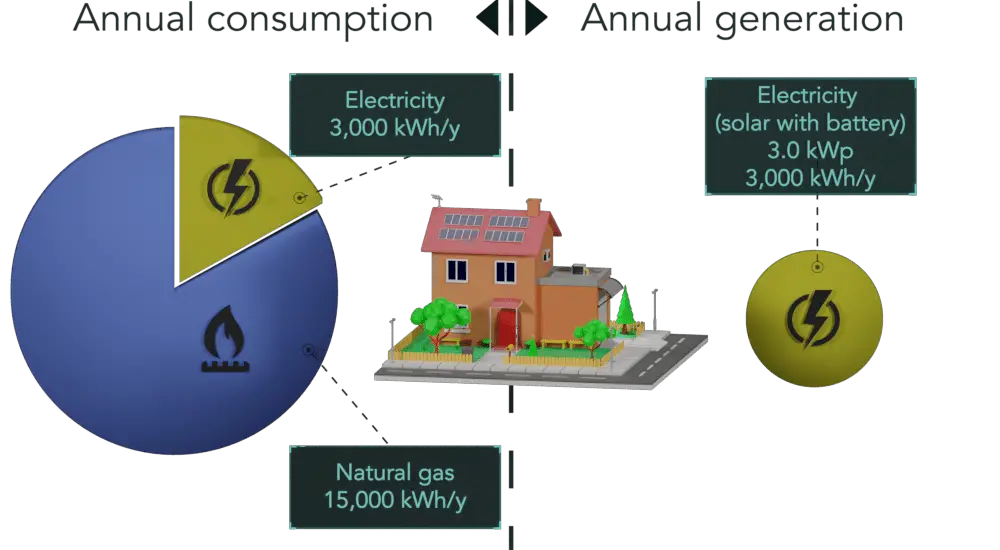
Note that more than half (51% in 2015) of a household’s annual energy consumption is for just two energy end uses: space heating and air conditioning. These mostly seasonal and energy-intensive uses vary significantly by geographic location, home size, structure, equipment, and the fuel used. Residential homes consume about 91 kWh (3,000/365 + 15,000/180) energy per winter day.
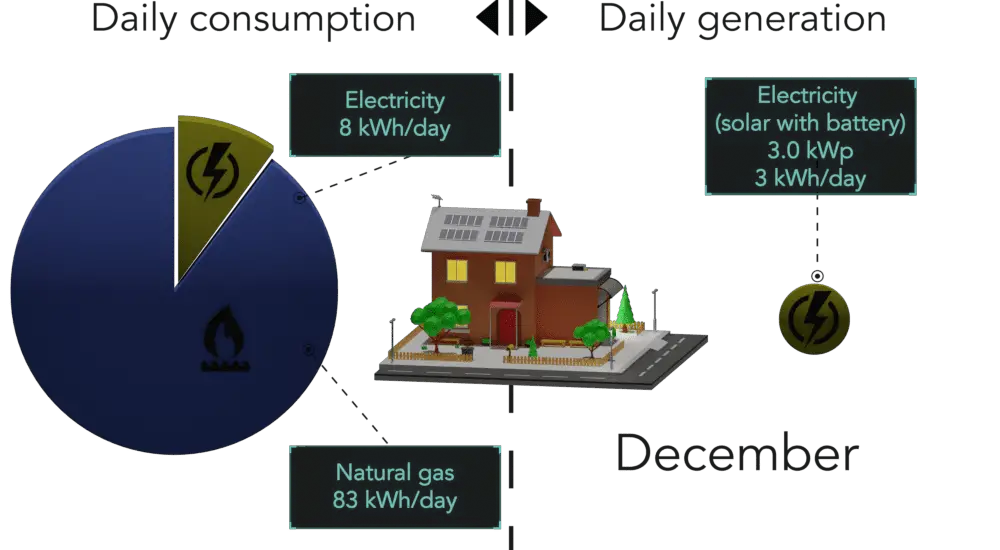
As you can see, space heating dominates in winter. This would require a really large overcapacity of solar power; otherwise, these residential homes need to be connected to an external source of energy.
